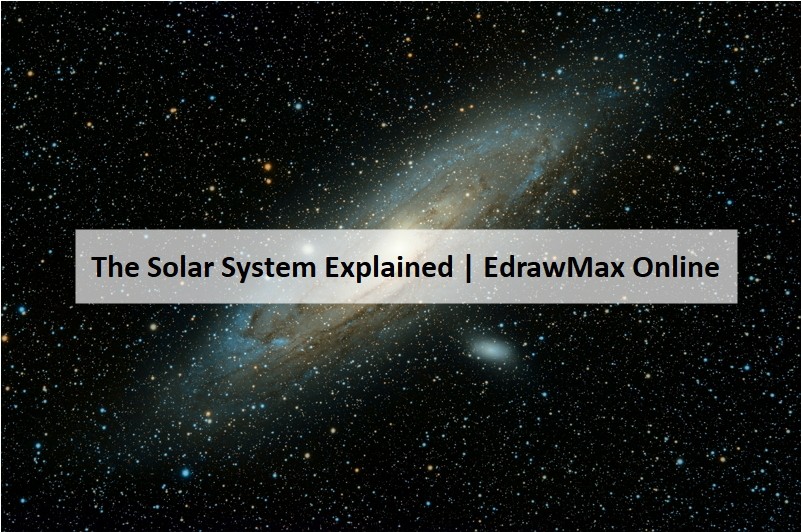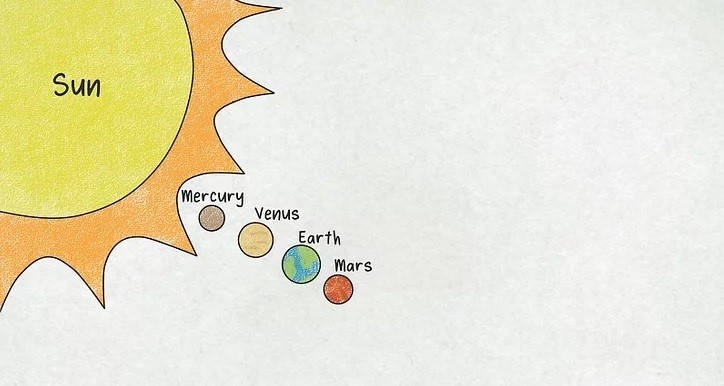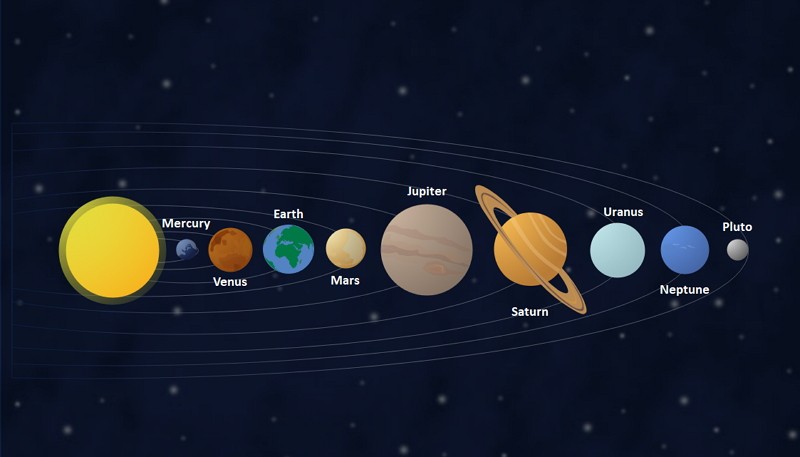A Guide to Understand Solar System with Diagram
The earth is a part of the solar system. Hence, to understand earth and other planets, it is a must to study the solar system. For that, the students require a good quality solar system diagram. It is tough to make a solar system diagram by hand. Therefore, students must use the EdrawMax Online tool, which can help them create a high-quality diagram for their lessons and projects.
1. The Solar System
There are multiple planetary systems present in the universe, and the one which has the sun as its center is known as the solar system. From the Latin word 'Solis,' the name solar is derived. Planets, dwarf planets, comets, asteroids, meteoroids, etcetera, celestial bodies make up the solar system. The sun is present in the Milky Way Galaxy and takes around 230 million years to complete one complete round on its spiral orbit.

1.1 The Classification of Solar System
The sun is the center of the solar system and is the site where the hydrogen and helium fusion reaction occurs. It radiates energy, electromagnetic radiation. Hence, blinding light comes out of it. The majority portion of the Solar system consists of a near-vacuum, interplanetary medium. The solar flares and coronal mass ejections are the reason behind the geomagnetic storms.
- Inner Solar System:
The inner solar system consists of terrestrial planets and asteroid belts. Silicates and metals are mainly there in this region. The bodies located in this part of the solar system are closer to the sun than other regions. The distance of less than 5 AU from the sun makes this inner solar system. The four inner planets have a rocky landscape and no ring. Therefore, they may or may not have moons. These four planets are Mercury, Venus, Earth, and Mars.
Apart from Ceres, other asteroids are called small solar system bodies and consist of rocky and metallic components. Asteroids having a size smaller than one meter are named meteoroids and micrometeoroids. Ceres is the largest asteroid and may be called a dwarf planet. Asteroids are classified into asteroids groups and families considering their orbital characteristics.
- Outer Solar System:
It consists of giant planets, their moons, centaurs, and short-period comets. Most planets in this region have water, ammonia, methane, which stay solid due to the low temperature. The four giant planets of the outer area are Jupiter, Saturn, Uranus, and Neptune.
Centaurs are icy comet-like entities. They can be classified as a comet because they also form coma while approaching the sun.
- Comets:
Comets are celestial bodies made of huge volatile ices. They have eccentric orbits and create coma as they enter the inner solar system. One can see their bright, long tail made of dust and gas from the earth. Comets can be short-lived (around 200 years) or have a long perpetual of thousands of years. Scientists deciphered that the Kuiper belt gives birth to short-lived comets while the long-lived ones generate from Oost Cloud.
- Trans-Neptunian Region:
The trans-Neptunian region or the third region of the solar system lies beyond the orbit of Neptune. This part mainly has the Kuiper belt, Pluto, and other dwarf planets.
Kuiper belt is a belt of debris and ice. The massive object in the Kuiper belt is Pluto. Charon is Pluto's moon and larger than Styx, Nix, Kerberos, and Hydra. Make is present in the Kuiper belt and tinier than Pluto, and scattered discs are present in this region. Eris is the massive scattered disc known to date.
- Farthest Region:
The ending point of the trans-Neptunian region, from where the interstellar space starts, is known as the farthest region. The heliosphere, detached objects, and hypothetical Oort cloud are present in the farthest region of the solar system.
1.2 Composition of the Solar System
The solar system includes eight planets, and the earth is one of them. They are:
- Mercury: Mercury is closest to the sun without any natural satellite. It has an iron core and a thin mantle part.
- Venus: Venus is close, in size, to earth and has the hottest surface temperature due to the greenhouse gases in the atmosphere.
- Earth: Among the inner planets, it is the largest and has the highest density. It has a liquid hydrosphere and air with 21% free oxygen. Plants and animals are present on the earth.
- Mars: It is smaller in size than Earth and Venus. Carbon dioxide makes up most of its atmosphere. It has volcanoes and rift valleys, and its natural satellites are Deimos and Phobos.
- Jupiter: It contains hydrogen and helium and has cloud bands and the Great Red Spot. It has Ganymede, which is the largest satellite of the solar system.
- Saturn: Saturn has a large ring and 82 natural satellites made of ice.
- Uranus: Uranus is the lightest planet of the outer planets and has an axial tilt of more than 90 degrees.
- Neptune: Neptune is slightly smaller than Uranus in size and has 14 moons.
Other than planets, there are moons, and dwarf planets like Pluto, thousands of asteroids, meteoroids, and comets.
2. How to Draw the Solar System Diagram?
The students must learn about the solar system if they want to learn more about the planetary system and the earth. They can use a solar system diagram to understand the distance of the plants from the sun.
2.1 How to Create Solar System from Sketch
However, it is challenging to create a solar system diagram by hand. The students need to follow these steps to create a solar system diagram by hand:
Step 1: To start with the drawing, they need to create a massive yellow circle at one side of the paper, representing the sun, the largest celestial body of the solar system. Mercury stays closest to the sun and smallest in size. The students need to draw a small circle near the sun. Just to its right, they have to draw a circle sizeable than the smaller one. Now, this is Venus. They can shade it with a yellowish-brown color.

Step 2: At the right of Venus, draw green and blue shaded earth, enormous than both the previous planets. The students need to create Mars next; it is a red planet present next (on the right side) to earth. For this, the students can draw a smaller circle with red and orange colors.

Step 3: After that, the students need to draw a big circle on the right side of Mars. This is Jupiter, and it is massive than all the others created so far. They need to give it a yellowish-orange shade. Students should now make a smaller circle on the right side of Jupiter. It is Saturn. It has a small ring around it. They can use yellow, gray, brown, and orange colors for the planet Saturn.

Step 4: The students can draw Uranus with a tilted ring around it. It is blue and tinier than Saturn in size. Finally, they have to draw another circle with an inclined ring representing Neptune. They can draw orbits around the planets in an elliptical shape considering the sun as the center while starting from and ending at the edges of the page.

2.2 How to Create Solar System Online
However, it can be challenging to create a high-quality solar system diagram by hand. Therefore, the students must use the EdrawMax Online tool. The tool is user-friendly and can help them to create a perfect solar system diagram for their lessons. Here are a few simple steps which they need to follow:
Step 1: To start with the process, the students need to open the EdrawMax Online tool and then open New. After that, they have to click on the Science and Education tab. Here, they can find a wide range of high-quality diagrams for learning and project works.

Step 2: To create a high-quality solar system diagram, the students need to select the astronomy option from the Science and Education tab. Then they can edit the solar system diagram as per their choice. It can allow them to create a good quality image for their projects and dissertation papers.

Step 3: After selecting the template they require, the students should modify it as per their choice. The tool gives the students some hassle-free options to edit their diagrams. They can work on those images according to their preference to create a high-quality solar system image.

Step 4: Once the students have finished modifying the diagram, they can save it in multiple formats. They can also export the solar system diagram to use in the future.

3. Solar System for Kids
Here are some fun facts for the kids to know:
- There are three different types of galaxies, known as elliptical, spiral, and irregular galaxies.
- Planets and asteroids of the solar system have moons, which exceed the count of 200.
- In 2006, the International Astronomical Union classified Pluto and Eris as dwarf planets.
- Enormous comets from the Oort cloud are generally invisible to naked eyes. They are only visible as they approach the sun.
- The sun has more than 99% of the elements present in the whole solar system.
4. Conclusion
The students must have thorough knowledge about the solar system. It will help them know about the sun and other planetary bodies. To use a solar system diagram for studies, they can create one by hand. However, the process is laborious. They can avoid the hassle by using the EdrawMax Online tool, which can help them draw the perfect solar system diagram.
In conclusion, EdrawMax Online is a quick-start diagramming tool, which is easier to make artery and vein diagram and any 280 types of diagrams. Also, it contains substantial built-in templates that you can use for free, or share your science diagrams with others in our template community.





